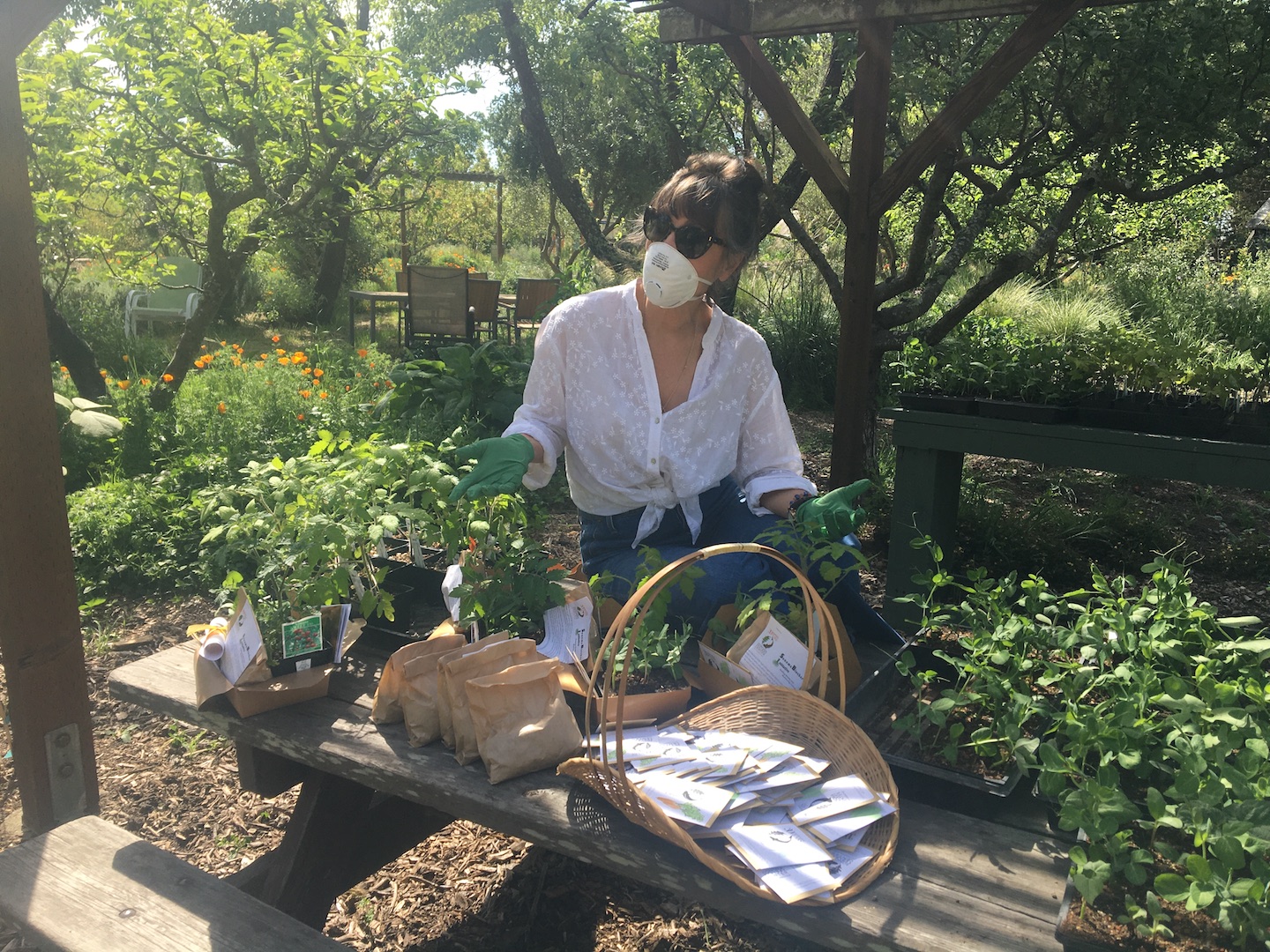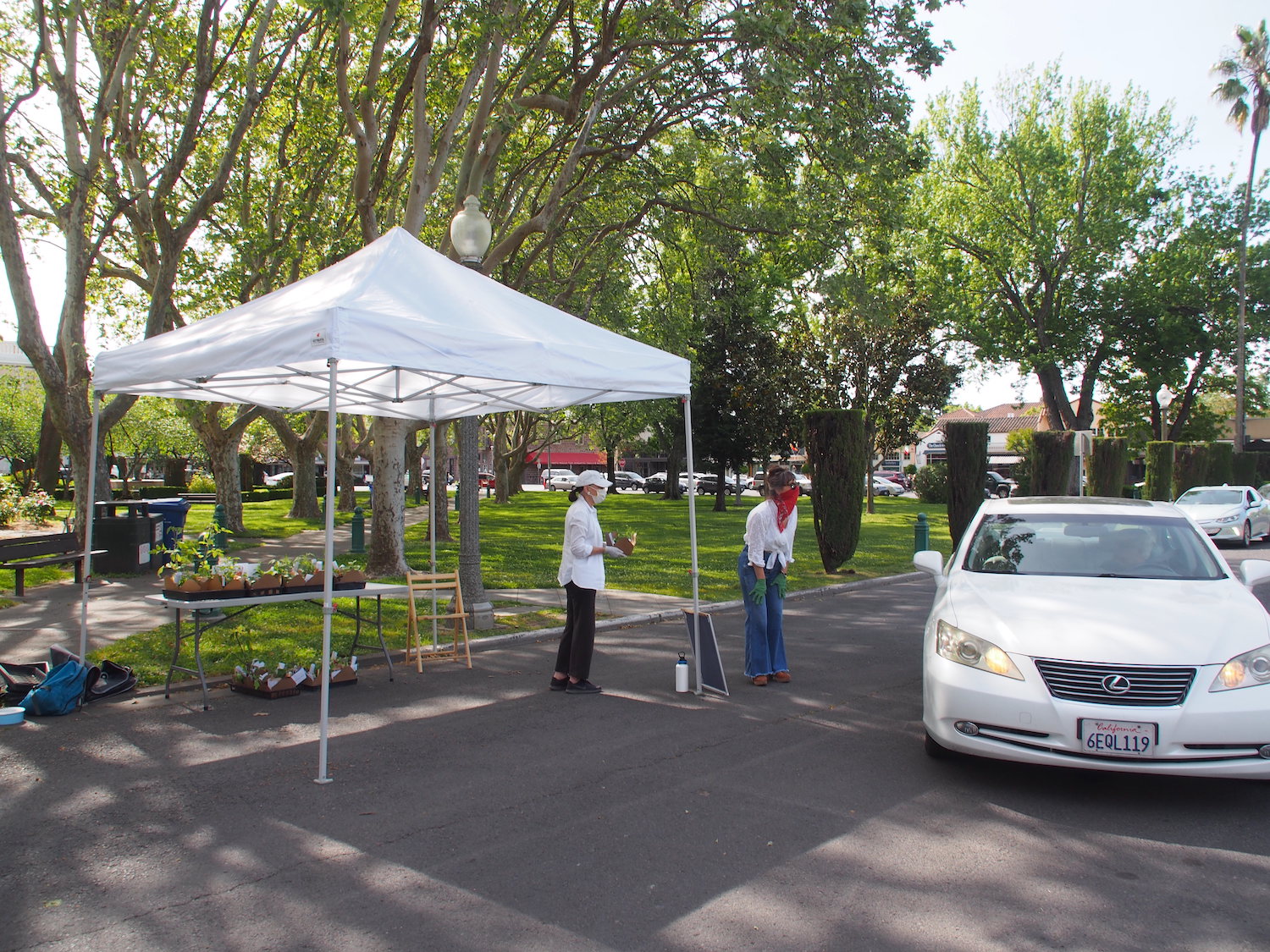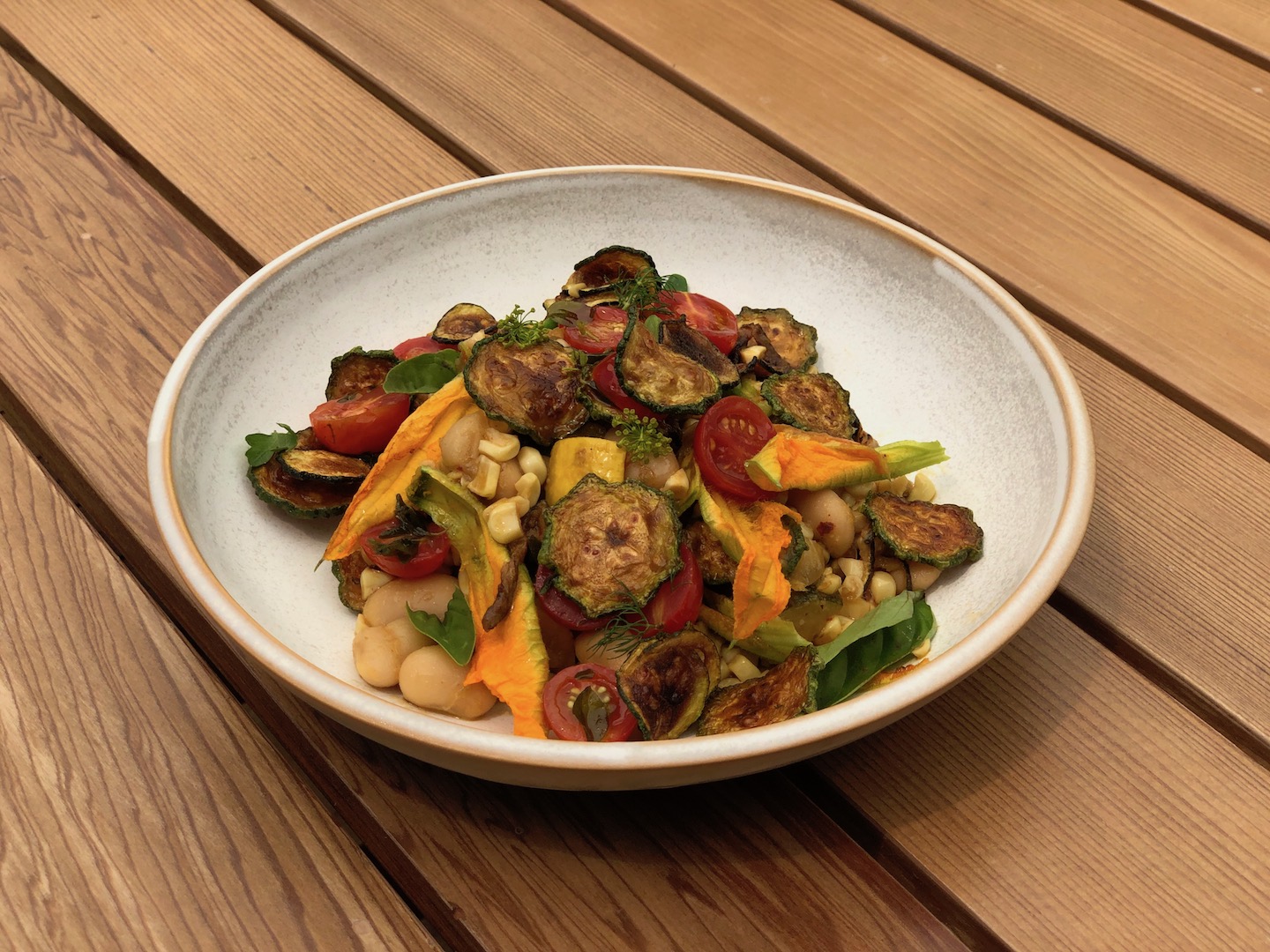

To launch our 30th anniversary year, we gifted 300 Victory Garden Starter Packs to the community on June 25th. Hundreds of people came to the Sonoma Plaza for the drive through give away.
We were blown away by how people wanted to take part in this community-wide garden project, so gifted more plants from Sonoma Garden Park, donated by Pauls Produce. Thank you to all of the wonderful volunteers and sponsors who made this celebration possible.

THANK YOU TO OUR WONDERFUL VOLUNTEERS!



We could not have done this without the help of a wonderful volunteer force, who spent days at Sonoma Garden Park preparing the 300 SEC Victory Garden Starter Packs, and our Leadership Circle, who helped SEC staff plan this celebration.
A special thanks to Bee-Well Farms for cultivating the 300 six-packs of melons, peas, sunflowers, beans and cucumbers. Thanks also to SRJC Horticulture for donating the tomato, eggplant and pepper plants, to Sonoma Market for donating boxes, and to Brenda McNeill for donating her artwork!
VICTORY GARDEN RECIPIES

We asked our friends at Valley Bar + Bottle to create a recipe using the SEC Victory Garden produce. Here’s what they created.
“This is a method, not a recipe in the strictest sense, but is how we approach making this dish at Valley. As your garden delivers its unique abundances throughout the season, utilize a variety of techniques to combine them together in a way that maximizes their diversity of flavors and textures.”
— Emma Lipp, Chef

One of our favorite local chefs, Kyle Kuklewski, has created a dynamic gazpacho recipe using many ingredients that you can harvest yourself, or find at the Saturday morning Harvest Market at Sonoma Garden Park. See the full recipe.
“Mother Nature is the true artist; the chef is merely the technician.”
—Marco Pierre White
PLANTING GUIDELINES FOR THE ORIGINAL #SECVICTORYGARDENS
Due to the recent cool weather, your plants may need a bit more time in their containers. Allow all of your plants to be well-established before transplanting to your garden. While you are waiting, water twice a day to ensure your starts don’t dry out before they are ready to be transplanted.
Marketer Cucumber: Cucumbers can be grown for fresh eating, pickling and more.
Soil/Transplanting: Plant 18 to 36 inches apart in well-drained soil. Do not disturb roots when transplanting.
Watering: Supply enough water to moisten the top 6 inches of soil. Cucumbers usually need 1-2 inches of water per week, equivalent to ½ -1 gallon of water per plant per week. Water consistently, because inconsistent watering can create misshapen cucumbers.
Fertilizer: When planting, mix compost with a little bit of organic fertilizer. During growth, use liquid fertilizer and apply directly to the soil near the stem one week after blooming begins and every 2-4 weeks thereafter. Granular fertilizer also can be used, but work it into the soil around the plant.
Harvesting: Once fruit bearing begins, pick daily to ensure steady harvest.
Tips: To maximize the amount of cucumbers and decrease leaves, use a trellis or tomato cage.
Summer Squash – Golden Scallopini: Delicious, saucer-shaped golden fruits with scalloped edges. Bush plants produce heavily and remain prolific through the season.
Soil/Transplanting: Plant 36 inches apart in well-drained soil. Enrich soil heavily with mature compost. Plant in full sun.
Watering: Water approximately 1 inch per week, equivalent to ½ gallon per week per plant.
Planting & Growing: Provide squash plants with deep mounds of organic matter, rich soil, and heavy, even water. All squash are extremely frost sensitive, so use mulch to heat soils in early spring and row covers to protect from frost at both ends of the growing cycle, especially in short growing seasons.
Harvesting: A delicious summer squash is most tender when picked small. Once squashes appear, pick frequently to ensure steady harvest.
Mammoth Melting Snow Peas
Soil/Transplanting: Fertile well-drained soil. Peas will tolerate most soils except heavy, impermeable clay. Work in plenty of compost to keep the soil friable (easily crumbles). Plant 18 to 24 inches apart. Do not disturb roots when transplanting.
Watering: Keep soil moist to promote rapid, uninterrupted growth. They do not perform well in dry conditions.
Growing: Use a trellis for the vines to climb upon and to make for easier harvesting.
Harvesting: You can pick snow peas at any time, but they are tastiest when the pods still have some play around the peas when you squeeze the pods. Regular picking will increase yields.
Golden Wax Beans (bush beans): Stringless bright yellow pods can produce pods 5-6 inches long. The Golden Wax beans are wonderful for canning, freezing and as a dry shell bean.
Soil/Transplanting: Wait until soil is about 60 degrees before planting beans. Beans prefer full sun, at least 6-8 hours a day. Plant 18 to 24 inches apart. Do not disturb roots when transplanting.
Watering: Water beans with about 1 inch of water a week, equivalent to ½ gallon per plant per week. Do not let the soil get dry while the beans are blooming, or the blooms will drop, and yields will be decreased.
Harvesting: Beans should be picked while the pods still snap, and the beans have not filled the pod out completely. Beans get tough and stringy if allowed to grow too big. Pick beans frequently to ensure the crop keeps producing.
Moon and Star Melons: Wonderful heirloom whose big round to oval dark green fruits are overlaid with yellow moons on a field of tiny gold star markings. Leaves are also splashed with tiny stars. Juicy-sweet, pink flesh.
Soil/Transplanting: Amend soil well with aged manure or compost. Make slightly rounded hills 2 feet in diameter and 5 feet apart. Do not disturb roots when transplanting.
Watering: Keep young vines well-watered – 1-2 inches per week, equivalent to ½-1 gallon of water per week per plant. Taper off watering as fruits ripens for best sweet flavor.
Harvest: Harvest your melon when tendrils next to the fruit turn brown and it is easy to pull from the vine, but before falling off. The spot where the fruit rested on the ground turns creamy yellow.
Rocky Ford Melon: Sweet and spicy-tasting heirloom muskmelon. The Rocky Ford Melon is well netted, slightly ribbed and produces delicious orange flesh.
Soil/Transplanting: Before planting, amend your soil with compost or aged manure so the melons have adequate nutrition. Make slightly rounded hills 2 feet in diameter and 5 feet apart.
Watering: Keep young vines well-watered – 1-2 inches per week, equivalent to ½-1 gallon of water per week per plant. Taper off watering as fruits ripen for best sweet flavor.
Harvest: Look for the rind color turning from green to yellow or tan. Harvest your melon when tendrils next to the fruit turn brown and it is easy to pull from the vine, but before falling off.
Tomatoes
Soil/Transplanting: Plant tomatoes 24 to 36 inches apart in full sun in well-drained soil that has been amended with compost.
Watering: Water newly planted tomatoes well to make sure soil is moist and ideal for growing, approximately 1-2 inches per week, equivalent to ½-1 gallon of water per week per plant. Consistent, even watering is important. Blossom-end rot can occur when there are wide fluctuations of moisture, which reduces uptake and movement of calcium into the plant. Taper watering as plant matures and tomatoes begin to ripen.
Growing: Use a tomato cage or trellis to train tomato vines. Optional: Prune tomato suckers. Tomato suckers, or side shoots, are the growths that appear in the junction between the stem and a branch of a tomato plant. Your plant may have more fruit if you let the suckers grow, but the tomatoes will be smaller and the plant will be more cumbersome, requiring a lot of effort to stake/trellis as the summer progresses.
Harvesting: A ripe tomato will be slightly firm with a fragrant smell. If it’s too hard, it probably needs more time to ripen. If it’s soft, it’s probably over-ripe.
Woodpecker Spinach (seeds):
Direct sow: Spinach germinates best in cool soil (spring). Seed spinach directly in bed 3/4″ apart, which is about 40 seeds per foot.
Watering: Keep soil moist, which also keeps soil cool and prevents bolting. Give 1-1½ inches of water per week, equivalent to ½-¾ gallon per week per plant.
Harvesting: Harvest small leaves in 3-5 weeks, depending on speed of growth.
Nectar Carrot (seeds)
Direct sow: Seed carrots directly in bed at a depth of ¼ inch, in rows six inches apart. Carrots begin to germinate between 10-25 days following seeding.
Growing: Once carrots reach 1-inch tall, thin carrots to 1 every 2 inches.
Watering: Evenly hand water carrots, keeping soil moist until carrots germinate. When carrots reach 1 inch high, you can switch to drip irrigation. Give carrots at least 1 inch of water per week, equivalent to ½ gallon per week. When you water your carrots, make sure to soak the soil completely. If you only wet the soil’s surface, the roots will not grow as deeply.
Harvesting: Harvest times may vary, usually 55-75 days to maturity. Carrots may be dug any time after they reach the desired size. Generally, the best harvest period lasts about 3 weeks (longer in cool, fall weather), after which time the roots may crack or the taste and appearance may decline. Nectar carrots are usually 7-8 inches long.
Sunflowers
Soil/Transplanting: When choosing a site, consider that sunflowers need a well-drained soil. They face the sun, so make sure they are in an open area of the garden. The taller varieties will cast shadows on other plants, so plant these at the north end of your garden.
Watering: It is best to water them regularly during their most important growth period which is about 20 days before and after flowering. Deep, regular watering helps encourage root growth, which is especially helpful with taller sunflower varieties bearing top-heavy blooms.
Harvesting: In the early fall, check flower heads for signs of maturity. The reverse side turns from green to a yellow brown. Large heads will nod downward. Seeds can be harvested, dried and/or roasted.
Green Star Lettuce (seeds): Vibrant green summer lettuce with shiny ruffled leaves and great heat tolerance.
Direct sow: Lettuce germinates best in cool soil. Direct sow in rows 2” apart and ⅛” deep.
Watering: Keep the soil moist, which also keeps the soil cool.
Harvesting: Cut lettuce holds best when harvested in the morning and cooled rapidly. For salad mix or baby leaf production, harvest individual leaves when they reach desired size, or cut evenly across the bed making sure to stay above the growing tip.
